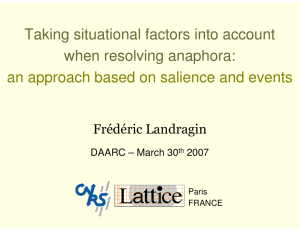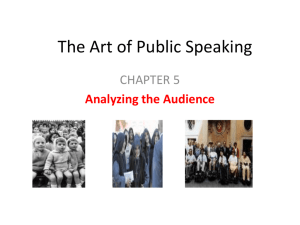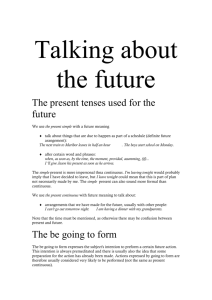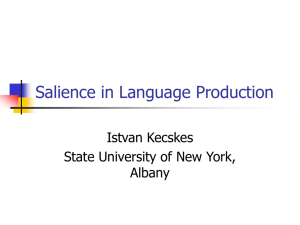Sep. 23
advertisement
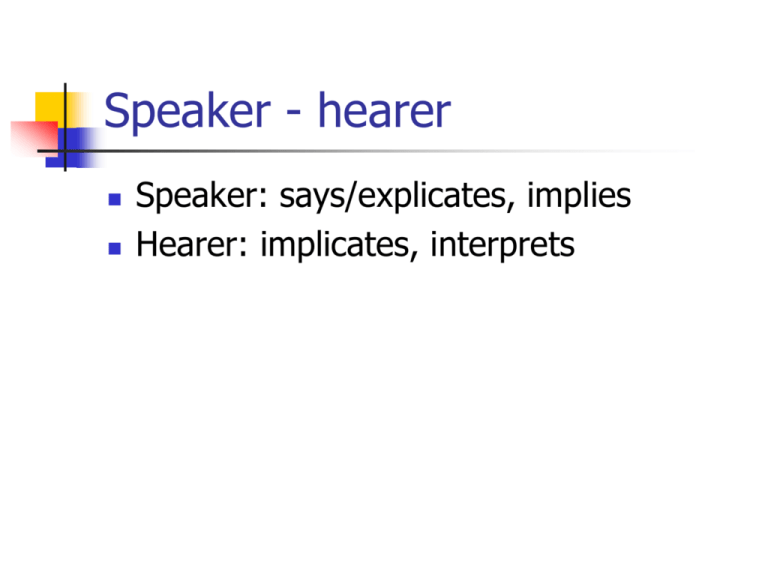
Speaker - hearer Speaker: says/explicates, implies Hearer: implicates, interprets What is implied in the following utterances? A. - Hey, get me another beer, will you? - No way, dude! Get it yourself! B. - Do you like that guy over there? - Well, I would not go to Hawaii with him. C. - Thank you for your kindness. - You bet. D. - What on earth has happened to that roast beef? - Well, the dog looks happy. Context Please read the following expressions and then write down the meaning that first comes into your mind, or give the situation in which you would use it: Help yourself. Give me a hand. Bless you. Hot stuff. Come on. Give me a break. Be my guest. What do you think about this quote? When a diplomat says yes, he means ‘perhaps’; When he says perhaps, he means ‘no’; When he says no, he is not a diplomat. When a lady says no, she means ‘perhaps’; When she says perhaps, she means ‘yes’; When she says yes, she is not a lady. Voltaire Socio-cognitive approach (SCA) Interlocutors are considered social beings searching for meaning with individual minds embedded in a socio-cultural collectivity. SCA takes into account both the societal and individual factors including cooperation and egocentrism that are not antagonistic phenomena in interaction. Cooperation and egocentrism Human beings are just as egocentric (as individuals) as cooperative (as social beings). “Egocentrism” in the SCA refers to attentionbias that is the result of prior experience of individuals. It means that interlocutors activate and bring up the most salient information to the needed attentional level in the construction (by the speaker) and comprehension (by the hearer) of the communication. The term “socio-cognitive” Integrated cognitive and social properties of systems, processes, functions, and models. Human functioning is the product of a dynamic interplay of personal, behavioral, and environmental influences. How people interpret the results of their own behavior informs and alters their environments and the personal factors they possess which, in turn, inform and alter subsequent behavior (Bandura 1986). Positivist vs. social constructivist Positivist: research focuses on procedural measures rather than interpretive perspectives. It is usually assumed that stored knowledge provides templates for thinking as well as acting. Meaning is embedded in words and symbols rather than in the mind that perceives them. Social constructivist perspective holds that knowledge and meaning are socially constructed. Knowledge and practice The difference is between words and texts whose meaning lies in the objective things they refer to, versus words and texts whose meaning lies in the practices they are used in. NNS1 (Thai female), NS1 (American female) NNS1: °I love sports.° NS1: What sports do you love? NNS1: I love football: (0.5) op- in here we call soccer. NS1: ↑Oh okay. Collective knowledge exists but it is interpreted, “privatized” (subjectivized) differently by each individual (Kecskes 2008). Son: - I met someone today. Mother: - Good. Oh, you got the broccolini? Thank you. Son: - She is a woman. Mother: - You did not have to tackle her too, did you? Son: - She is a police officer. Mother: - Are you in trouble? Son: - I don’t think so. While the positivists put more emphasis on the individual, social constructivists focus on the collective How does all that individuation get integrated and leveled out in the collective? How is the collective acquired, preserved, and passed on by individuals? Differences between current pragmatic theories and SCA Features of SCA 1) Cooperation and egocentrism are not conflicting , such that the a priori mental state supporting intention and common ground versus the post factum emergence of intention and common ground may converge to a body of integrated background knowledge for the interlocutors to rely on in pursuit of a relatively smooth communication. Example (Movie: “Angel Eyes”) Situation: A policewoman in uniform is driving the car, and the man sitting beside her is starring at her. PW: - What? M: - I was trying to picture you without your clothes on. PW: - Excuse me? M: - Oh no, I did not mean like that. I am trying to picture you without your uniform. PW: - Okaay? M: - I mean, on your day off, you know, in regular clothes. 2) Speaker meaning as important as hearer implicature No “impoverished” speaker meaning in SCA. The speaker utterance is a full proposition with pragmatic features reflecting the speaker’s intention and preferences and expressing the speaker’s commitment and egocentrism (in the cognitive sense). The proposition expressed is “underspecified” only from the hearer’s perspective but not from the speaker’s perspective. Example - How is John doing at his job at the bank? - Oh, quite well. He likes his colleagues and he has not been sent to prison yet. 3) Communication is characterized by the interplay of two sets of traits that are inseparable, mutually supportive, and interactive: Individual traits: Social traits: prior experience actual situational experience salience relevance egocentrism cooperation attention intention Interaction between traits Individual traits (prior experience salience egocentrism attention) interact with societal traits (actual situational experience relevance cooperation intention). Each trait is the consequence of the other. Operation Prior experience results in salience which leads to egocentrism that drives attention. Intention is a cooperationdirected practice that is governed by relevance which (partly) depends on actual situational experience. Privatalization Communication is the result of the interplay of intention and attention motivated by socio-cultural background that is privatized individually by interlocutors. Privatalization (making something private, subjectivize something), a process through which the individual blends his prior experience with the actual situational (current) experience, and makes an individual understanding of collective experience. Example Son: - I met someone today. Mother: - Good. Oh, you got the broccolini? Thank you. Son: - She is a woman. Mother: - You did not have to tackle her too, did you? Son: - She is a police officer. Mother: - Are you in trouble? Son: - I don’t think so. Intention in SCA Intention is considered a dynamically changing phenomenon that is the main organizing force with attention in the communicative process. Intention is not only private, individual, pre-planned and a precursor to action; it is also emergent and social. Not dichotomy: rather, a priori intention and emergent intention are two sides of the same phenomenon that may receive different emphasis at different points in the communicative process. Emergent intention John: Want to talk about your trip? Peter: I don’t know. If you have questions… John: OK, but you should tell me… Peter: Wait, you want to hear about Irene? John: Well, what about her? Peter: She is fine. She has…well…put on some weight, though. Attention motivated by salience As a semiotic notion, salience refers to the relative importance or prominence of signs. The most probable out of all possible. In SCA prior experience results in salience that leads to egocentrism that drives attention. Graded Salience Hypothesis Salient information is superior to less salient information and often (Giora 2003: 15), though not always, to unstored information, such as novel information or information inferable from context (see Giora 2003:10–11). Salient meanings of lexical units (e.g., conventional, frequent, familiar, or prototypical meanings) are processed automatically, irrespective of contextual information and strength of bias. Gay, cool, patronize, penitrate Canceling highly salient meaning: sexual connotation In one of his films (“Survivors”) Robin Williams says the following: - I had to sleep with the dogs. Platonically, of course…” Difference between GSH and SCA 1) 2) 3) Since interlocutors both produce and interpret language their linguistic behavior is affected by salience both in production and comprehension. GSH emphasizes the importance of stored information, while SCA considers salience to be both a stored (inherent salience and collective salience) and an emergent entity (actual situational salience). Salience is language and culture specific.
